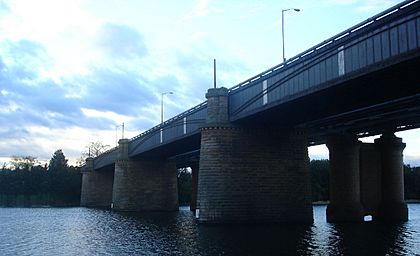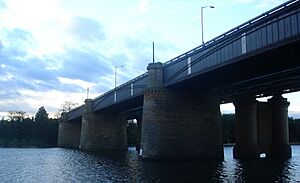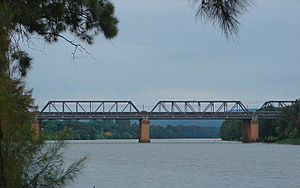Victoria Bridge (Penrith) facts for kids
Quick facts for kids Victoria Bridge over Nepean River |
|
|---|---|

Victoria Bridge in Penrith over the Nepean River
|
|
| Coordinates | 33°44′46″S 150°40′54″E / 33.7461°S 150.6818°E |
| Carries |
|
| Crosses | Nepean River |
| Locale | Penrith, Sydney, New South Wales, Australia |
| Official name | The Nepean Bridge |
| Other name(s) |
|
| Named for | Queen Victoria |
| Owner | Roads and Maritime Services |
| Preceded by | Regentville Bridge (M4 Motorway) |
| Followed by | Victoria Railway Bridge (since 1907) |
| Characteristics | |
| Design | Box girder |
| Material | Wrought iron |
| Trough construction | Steel with reinforced concrete |
| Pier construction | Sydney sandstone and concrete |
| Total length | 181 metres (594 ft) |
| Number of spans | 5 |
| History | |
| Designer |
|
| Engineering design by |
|
| Constructed by | William Piper |
| Construction begin | 1864 |
| Construction end | 1867 |
| Construction cost | A£110,000 |
| Replaces | Punts |
| Statistics | |
| Daily traffic | 25,000 (2009) |
| Official name: Victoria Bridge; The Nepean Bridge; RTA Bridge No. 333 | |
| Type: | State heritage (built) |
| Criteria: | a., b., c., d., e., f., g. |
| Designated: | 27 May 2016 |
| Reference #: | 1950 |
| Type: | Road Bridge |
| Category: | Transport - Land |
| Builders: |
|
| Designated: | 28 September 1982 |
| Reference #: | 3120 |
The Victoria Bridge (Penrith) is a very old and important bridge in New South Wales, Australia. It crosses the Nepean River in Penrith, a suburb of Sydney. This bridge was first built to carry both trains and horse-drawn vehicles. Later, it was changed to carry only road traffic on the Great Western Highway.
The bridge was designed by John Whitton, a famous railway engineer. It was built between 1862 and 1867. Today, it is managed by Roads and Maritime Services. It's the oldest bridge still standing that crosses the Hawkesbury–Nepean River system. In 2009, about 25,000 vehicles used the Victoria Bridge every day. It is also known as The Nepean Bridge and RTA Bridge No. 333.
Contents
Bridge History
Before 1856, people crossed the Nepean River using a shallow spot called Emu Ford or by a boat called a punt. When the river flooded, travelers could be stuck in Penrith for days or weeks. A small village grew there to help these waiting travelers.
When gold was found west of the Great Dividing Range, many more people, goods, and animals needed to cross the river. This led to efforts to build a permanent bridge. Two timber road bridges were built near where the Victoria Bridge is now.
Early Bridge Attempts
A private company built a timber bridge in December 1855. It was about 213 metres (700 ft) long and 9 metres (30 ft) wide. This was the first bridge across the Nepean River in that area. However, this bridge was destroyed by floods in August 1857. The middle parts of the bridge were washed away because the timber supports were not strong enough.
The company decided to rebuild the bridge. They used some of the old supports, even though engineers warned against it. The new bridge was stronger, but a huge flood in May 1860 destroyed it completely. This ruined the company that built it. After this, the government provided two punts to help people cross. But these punts were also damaged by a flood in 1867.
The loss of the punts happened when plans for the Great Western Railway were being made. The railway needed a bridge over the Nepean River to connect Penrith with Bathurst. It was decided that the new bridge would carry both the railway line and a single lane for road traffic. This was meant to be a temporary solution.
Building the Victoria Bridge
The Victoria Bridge was designed by John Whitton, the chief railway engineer in New South Wales. His design was checked by Sir John Fowler, a famous railway engineer from Britain. Whitton designed the bridge to carry two railway tracks, even though the road part was only temporary. He raised the bridge deck by two metres (six feet) after seeing how powerful the 1860 flood was.
The bridge uses "half-through girders," which are like tall boxes made of strong wrought iron plates. This design helped keep the bridge low enough for trains but high enough for floodwaters to pass under. This was a very modern design for its time. It used ideas from other famous bridges like the Britannia Bridge in Wales.
Construction Challenges
Building the bridge was split into several jobs. The first contract for the piers (the supports in the water) was given to William Tyler in 1862. But floods in 1863 and 1864 damaged his equipment, and he had to stop work. The contract was then given to W. Watkins, who finished the piers on time.
The iron parts for the bridge came from a company in England called Peto, Brassey and Betts. This same company had supplied iron for another important bridge, the Menangle Railway Bridge, built in 1863. The timber parts leading up to the bridge were built by Mr Baillie. The total cost for the 1,100 tonnes (1,213 short tons) iron bridge was about A£110,000.
Soon after the bridge opened in 1867, a huge flood hit again. It damaged the timber parts on the western side. But the main iron part of the bridge held strong! This showed how well it was designed. Later, some damaged timber sections were replaced with stronger wrought iron parts. The bridge was so well-designed that it was featured in a book about modern bridges in 1872.
The Victoria Bridge changed the local economy. Before it opened, Penrith was a busy trading hub because trains stopped there. Once the bridge opened, allowing trains and roads to go further west, other towns grew. It also helped the tourist industry in the Blue Mountains.
Over time, more trains and heavier engines were used. So, in 1907, a new steel bridge was built right next to the Victoria Bridge. This new bridge carried two railway lines. The original Victoria Bridge was then changed to carry two lanes of road traffic and a footpath. In the 1930s, the timber parts of the bridge's approaches were replaced with stronger steel and concrete.
The area around Victoria Bridge has always been popular for recreation. Since the 1850s, it has been used for rowing competitions. The bridge was very important for connecting the railway to western New South Wales and for providing a continuous road link across the river.
Victoria Bridge Today
Today, the Victoria Bridge is still an important link. However, the M4 Western Motorway now carries most of the traffic to and from the Blue Mountains. This newer motorway crosses the Nepean River at Regentville.
The Victoria Bridge is still a local landmark. It's a central part of sporting events on the Nepean River. It also connects Penrith with suburbs like Emu Plains on the western side of the river. The railway bridge built in 1907 still carries the Main Western and Blue Mountains railway lines.
There is a pedestrian path on the bridge, about 1.3 metres (4 ft 3 in) wide. In 2018, a new bridge for walkers and cyclists, called the "Yandhai Nepean Crossing," opened south of the Victoria Bridge. This new bridge is a straight steel truss bridge, about 284 meters long.
Bridge Design and Features
The Victoria Bridge is a "continuous iron through-bridge." This means the road deck is built between the main support beams, not on top. The three main iron beams are 181-metre-long (594 ft) and are connected as one piece. This was a very new idea in 1867.
The bridge is supported by hollow stone piers (supports) made of Sydney sandstone. There are also concrete supports for the parts of the bridge leading up to the main section. The main beams are made of riveted wrought iron plates, which are very strong. The total weight of the wrought iron is about 1,100 tonnes (1,213 short tons).
You can see vertical T-shaped parts on the sides of the main beams. These are called stiffeners. They stop the thin iron plates from bending or buckling. There are also decorative curved parts on the outside of the beams. These don't help with strength but make the bridge look nicer.
You can find flood markers on the side of the easternmost stone pier. These show how high the river has risen during past floods. There are also old light posts on the northern side of the bridge.
Bridge Condition
As of 2008, the bridge was in very good condition. There was little rust on the iron parts, and the concrete and stone parts also looked good. It's possible that parts of the old bridges or construction equipment are still in the riverbed.
The bridge has been changed a few times over the years. But most of its original structure is still there.
- 1869: The western approach sections were rebuilt after a flood.
- c. 1870-90: Guides were added to the timber road surface to help horse-drawn vehicles stay straight.
- 1883: A fence was put between the railway track and the road lane. A warning bell was also installed for approaching trains.
- 1907: The railway line was removed from Victoria Bridge when the new railway bridge opened. The deck was rebuilt for two lanes of road traffic.
- 1934: The approach sections were rebuilt using steel and concrete.
- Later (date unknown): The footpath was rebuilt to carry utility pipes.
Why Victoria Bridge is Important
The Victoria Bridge is very important to the history of New South Wales. It is one of only two "wrought iron-through girder" bridges left in the state. It's special because it still looks very much like it did when it was built, unlike the Menangle Bridge, which has been changed a lot.
The design of Victoria Bridge was cutting-edge technology in 1862. It used advanced ideas from famous British engineers like Robert Stephenson. It also has the longest spans (distances between supports) of any metal girder bridge in New South Wales.
The bridge was key to bringing railways to western NSW. It is also linked to its designer, John Whitton, who was a very important engineer for the NSW Railways.
Heritage Significance
The Victoria Bridge is listed on the New South Wales State Heritage Register. This means it's recognized for its historical, technical, and social importance.
- Historical Importance: It played a vital role in developing road and rail transport across NSW from the 1860s. It was the first successful bridge crossing the flood-prone Nepean River at Penrith.
- Association with Important People: It's linked to John Whitton, who designed the Great Western Railway. It's also connected to John Fowler, a famous British engineer who checked Whitton's plans.
- Technical and Creative Achievement: The bridge's design was based on advanced engineering principles. It's the most complete example of its type in NSW. Its strong design helped it survive many floods.
- Community Connection: People in Penrith, Sydney, and the Blue Mountains value the bridge. It's a landmark and has been central to tourist and sporting activities on the Nepean River, like rowing.
- Research Potential: As one of Australia's oldest metal bridges, it can teach us a lot about early bridge design and construction.
- Rarity: It's the only "iron-through girder" bridge in NSW that hasn't been greatly changed. It's one of only two such bridges still standing in the state.
- Representative Example: It shows the advanced bridge design of its time and how important high-quality bridges were for opening up western NSW to the railway.
Images for kids








